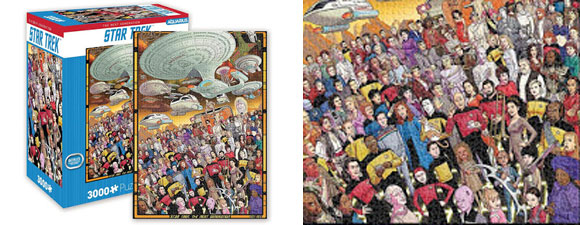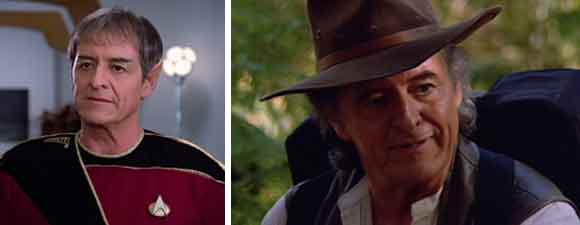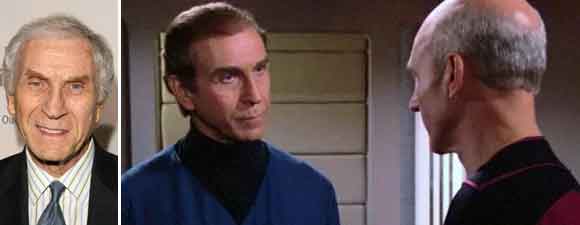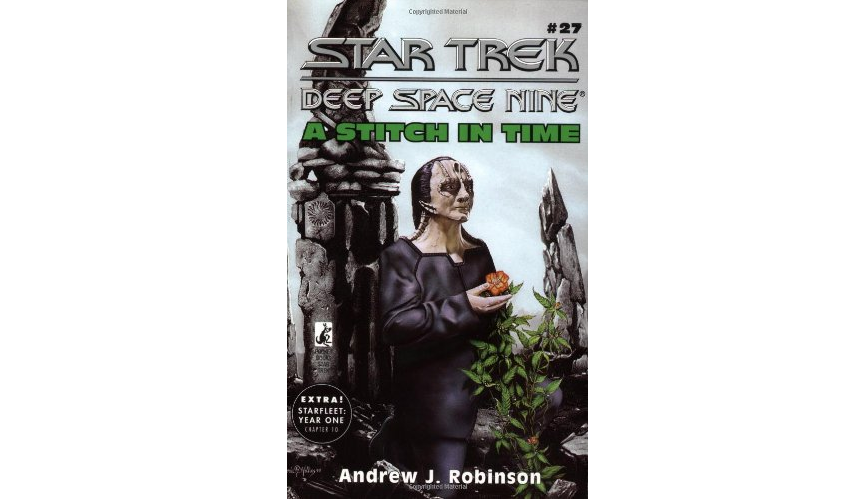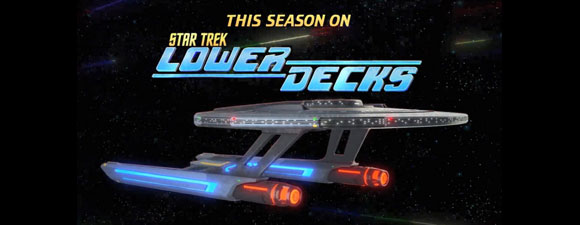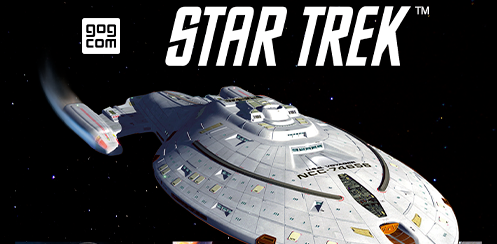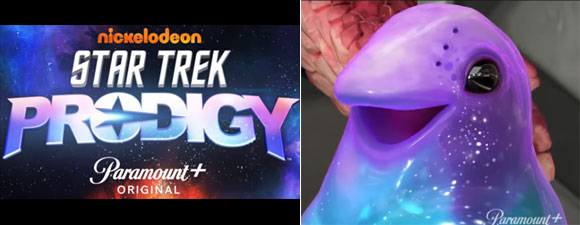Retro Review: The Chase
7 min readPicard is drawn by an archaeological mentor into a competition with Klingons, Cardassians and Romulans to solve an ancient mystery.
Plot Summary: Picard’s onetime archaeology mentor, Professor Galen, pays a surprise visit to the Enterprise to ask Picard to join him on a mission with very great implications. Though tempted, Picard must decline since he cannot leave the Enterprise long enough to carry out the research. Galen leaves angrily and is killed shortly afterward when Yridians attack his shuttle. Feeling guilty and intrigued by the seemingly random blocks of numbers that Galen left on his ship’s computer, Picard takes the Enterprise to Galen’s intended destination, skipping a diplomatic conference. When the ship arrives at Indri VIII, all life on the planet is being destroyed by an unknown weapon, which leads Picard to guess that the number sequences might represent an organic formula. Crusher examines them and concludes that the sequences come from fragments of DNA from species of 19 different planets. When Picard heads to the professor’s next destination, Loren III, he finds that two Cardassian warships and a Klingon bird of prey have arrived first. Cardassian Gul Ocett threatens to fire on anyone who beams to the surface and Klingon Captain Nu’Daq admits that he destroyed the surface of Indri VIII to prevent anyone else from obtaining samples there. Picard suggests that they share their samples and see whether, as LaForge hypothesizes, these fragments represent pieces of a computer algorithm. When they discover that they are all still missing a DNA fragment, Picard has the Enterprise computer search for the likely location where the sample can be found. The Cardassians immediately leave the others behind, and Picard and Nu’Daq agree to work together. Once the Enterprise arrives at the Vilmoran system, they find not only the Cardassians but a group of Romulans as well searching for the missing DNA fragment. While the three onetime Starfleet enemies quarrel, Crusher retrieves a sample of fossilized DNA and uses the tricorder to complete the computer algorithm. The tricorder projects a hologram of a humanoid who tells them that her race seeded its DNA throughout the galaxy in the hope that their descendants would have to work together to solve the secret of their common ancestry. The Klingons and Cardassians refuse to believe that this could possibly be true, but the Romulan commander tells Picard that it would seem they are not dissimlar after all and suggests that perhaps one day the galaxy will find the fellowship their progenitors imagined.
Analysis: “The Chase” is a bit talky and slow to get started, but once the mystery begins to unfold, it becomes one of The Next Generation‘s more enjoyable stories. We’ve had so many Picard-centered episodes lately that I doubt we need the extended introduction to his Academy professor and his angst about whether he should have become an archaeologist. That’s not a new topic, nor is his friendship with Crusher, though I can’t help wondering why we’re shown so many instances of intimacy between them when ultimately the writers have no grand scheme for a relationship. But as soon as the secret of the DNA fragments falls into Picard’s lap and the ship takes off in search of clues, the episode has a whole new energy, even before the Cardassians and Klingons appear on the scene, giving us something like The Maltese Falcon where a group of people who neither like nor trust each other must work together to find a prize worth killing for. The idea of a secret encoded in our “junk” DNA is just delightful. The human genome contains lots of information we can’t comprehend, including long sequences that seem to be random; creationists like to point to these fragments as proof that a higher power had a hand in human development, but Star Trek proposes an alternate theory, similar to the theories Kirk and Picard always offer when faced with seemingly divine powers: it’s not God, but a science far more advanced than our own. There’s nothing seemingly super-human about the humanoid progenitor chosen to speak for her species (played by Salome Jens, thus bearing an unnerving resemblance to the shapeshifting Founders of the Gamma Quadrant). She has similar aspirations for galactic peace to many of the humans we’ve met in Star Trek, and she seems almost frail in her desire to be remembered.
In fact, the humanoid progenitors seemingly acted in a most disturbing manner, interrupting the natural evolution of planets by dumping their own DNA into the mix. It would have had results like freeing Burmese pythons in Florida – with no natural predators, they can gobble up all the local fauna. Indeed, I wonder if there were any “original” Earth life forms left after this alien DNA was seeded. It was suggested in the original series’ “Return To Tomorrow” that the humanoid races of the Milky Way had a common ancestor – an idea accepted by Spock, who said it would explain some issues in Vulcan prehistory, which is Romulan prehistory as well. The beings from “Return To Tomorrow” destroyed their own species in a cataclysmic war, and in any event weren’t old enough to be the proto-humanoids in “The Chase,” who claimed to have visited Earth-like planets while they still had primordial oceans, but it makes complete sense that the humanoids of the galaxy must be descended from common seed since most of them can reproduce with one another – the fact that the Vulcan Sarek and the human Amanda produced Spock, or that the Klingon Worf and half-human K’Ehleyr accidentally conceived Alexander without any medical intervention, is very strong evidence that they’re members of the same genus. So it’s nice to see Star Trek address this medical conundrum, since otherwise it should be easier for humans to reproduce with chimpanzees than with humanoids who evolved on another planet.
It’s also nice to see Crusher get some technical work when so often see her only in her role as doctor/nurturer. It’s particularly appealing to watch her scientific competence in an episode where she’s also serving as Picard’s friend and sounding board. He’s surprisingly dismissive of Troi, in whose skills as a counselor he’s been much more trusting this season; in “The Chase” he gets to skip out on talking to her about his feelings concerning Galen once because Worf summons him to duty, but when Troi visits him after his announcement that he plans to skip out on a Starfleet conference in favor of researching the professor’s work – the sort of thing for which Kirk expects to be busted in “Amok Time” when he evades a Starfleet order to attend a diplomatic mission in favor of taking care of an old friend – Picard all but tosses her out of his ready room, insisting that he’s neither mourning nor on a wild goose chase. Starfleet must have an enormous amount of confidence in Picard to allow him to leeway to ignore delegates at a peace conference waiting for him to serve as mediator. And this is before anyone knows the Klingons, Cardassians and Romulans are involved; I imagine their appearance ups the stakes dramatically for the admirals, but if Galen had died in pursuit of an unknown artifact at the hand of a Yridian, would Picard have been let off the hook for pursuing what looks a lot like a personal quest? Considering that the episode begins with Picard dismissing the idea that he could go off to do research with Galen, who compares the captain to a Roman centurion stuck patrolling the provinces, it would have been useful to get a glimpse of the authority figures waiting in the background.
The casting for “The Chase” is a lot of fun – in addition to Jens, who played a major role later on Deep Space Nine, the wonderful character actor Norman Lloyd plays Galen, while Gul Ocett is played by Linda Thorson from The Avengers. We don’t get to see much subtlety from any of the aliens, who spend most of their screen time posturing to intimidate one another, but the contrasts in style are telling – the Klingon mostly bluster, the Cardassians nasty, the Romulans quiet and sneaky yet just as determined. I don’t know whether to call it heartwarming or sad how alike everyone seems – even Picard, who is so determined to learn the secret of the DNA fragments that he doesn’t take Nu’Daq’s head off for destroying all life on an entire planet, let alone for trying to bribe Data on his own ship. Yet the ending is hopeful despite Cardassian and Klingon intransigence; one is already an ally, and the normally self-serving Romulans seem willing to ponder the implications of shared ancestry. It’s Infinite Diversity in Infinite Combinations in action – Star Trek’s ideology encapsulated in a brief lecture from an ancient parental figure.
